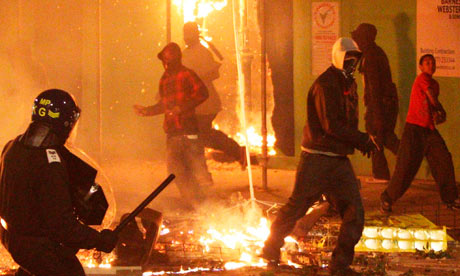Gangs did not play a pivotal role in the August riots, according to the latest official analysis of those arrested during the disturbances.
Official figures show that 13% of those arrested in the riots have been identified as gang members, rising to 19% in London. But even where police identified gang members being present, most forces believe they did not play a pivotal role.
The finding by senior Whitehall officials is a blow to the principal response to the riots being pushed strongly by the work and pensions secretary, Iain Duncan Smith – that tackling gang culture is key to preventing any repeat of the disturbances.
The Ministry of Justice (MoJ) and Home Office background analysis shows that those arrested during the riots mainly came from deprived areas and had the poorest educational backgrounds. More than two thirds of the young people involved were classed as having special educational needs and one third had been excluded from school in the past year. More than 42% received free school meals.
The analysis of the ethnic backgrounds of those brought before the courts for riot-related offences varied significantly from the local population, with 42% of defendants white and 46% black. Only 7% were Asian.
The ethnic composition of court defendants was particularly different from the local area profile in three places: Haringey in north London, where 55% of defendants were black compared with 17% of young people locally; Nottingham, where 62% of defendants were black compared with 9% locally; and Birmingham, where 46% of defendants were black compared with 9% of young people locally.
The Home Office figures were based on 5,175 crimes recorded across 19 police forces – the vast majority in London, Manchester and Birmingham. More than 40% happened in town or city centres and 20% in shopping malls or other "defined retail cores". Half the crimes were committed against commercial premises. A total of 2,584 shops and other commercial premises were targeted in the riots.
The MoJ figures confirm that 90% of those arrested in the riots were male. More than half were under 20. They also confirm the more punitive nature of the courts, with 42% of those tried in magistrates courts sent to prison, compared with only 12% normally.
The analysis of arrests says that 13% or 417 individuals were identified as being affiliated to a gang by the 10 police forces who suffered the most extensive disorder.
"Outside London, the majority of forces identified fewer than 10% of all arrestees as gang members, and only two non-London forces estimated figures in excess of this – West Yorkshire (19%) and Nottinghamshire (17%). For these two forces, these percentages only represent relatively small numbers of arrestees (13 and 20 respectively)," says the Home Office report.
"In London, police reported that 19% of arrestees – 337 suspects drawn from 169 different gangs – were identified as gang members," the report adds. "However, even in London, the great majority of arrestees (81%) were not identified as being members of gangs." Home Office statisticians acknowledge that the way the 10 different forces identified gang members was not completely consistent but add: "Most forces perceived that where gangs were involved, they generally did not play a pivotal role."
The report says some incidents suggested "orchestrated offending related to gang activity", but stresses that clear examples of this were "few in number". They included targeting high-value property in Manchester and "diversion tactics". Gang members were also involved in a handful of more serious incidents including the shooting incident in Birmingham.
This analysis contrasts sharply with the picture presented to the Conservative party conference by Duncan Smith, when he said gangs played "a significant part" in the riots. An anti-riots tsar, Louise Casey, has been appointed to lead the drive against gang culture.
Instead, the MoJ analysis stresses the poor educational and socio-economic background of those arrested in the riots. "It is clear that compared to population averages, those brought before the courts were more likely to be in receipt of free school meals or benefits, were more likely to have had special educational needs and be absent from school, and are more likely to have some form of criminal history. This pattern held across all areas looked at," it says.










